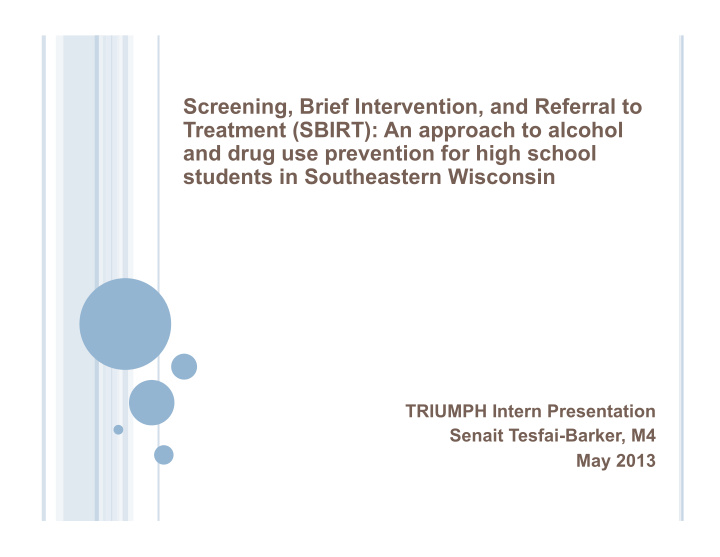



Screening, Brief Intervention, and Referral to Treatment (SBIRT): An approach to alcohol and drug use prevention for high school students in Southeastern Wisconsin TRIUMPH Intern Presentation Senait Tesfai-Barker, M4 May 2013
W HAT IS SBIRT? Comprehensive, integrated, public health approach to deliver early intervention and treatment services for persons with substance use disorders and those at risk of developing these disorders. Reference: Substance Abuse and Mental Health Services Administration (SAMHSA)
SBIRT Screen Brief Assessment Low risk Intermediate risk High risk Intervene Refer Reassure and reinforce Follow-up and support
C ONTINUUM OF S UBSTANCE A BUSE Low risk High Mild risk Severe problems problems Absti- Heavy use nence Loss of control Cravings Preoccupation • U NIVERSAL SCREENING IS IMPORTANT BECAUSE MANY MORE FALL AT THE HIGH RISK AND MILD PROBLEMS THAN SEVERE PROBLEMS R EFERENCE : M ANWELL , J OURNAL OF A DDICTION , 1998
M ETHOD : CRAFFT F orget C ar F amily/ R elax Friends A lone T rouble Knight JR, Sherritt L, Shrier LA, et al. Validity of the CRAFFT Substance Abuse Screening Test Among Adolescent Clinic Patients. Arch Pediatr Adolesc Med 2002; 156:607.
W ISCONSIN ’ S P ROBLEM In the Youth Risk Behavior Survey, the Centers for Disease Control ranked Wisconsin: 1 st in the rate of current alcohol use among youth. 3 rd in the rate of binge drinking among youth 4 th in the rate of youth who rode with a driver who had been drinking 5 th in the rate of youth who drove after drinking.
T HE P ROBLEM : A LCOHOL U SE R EFERENCE : CDC Y OUTH R ISK B EHAVIOR S URVEY
T HE P ROBLEM : B INGE D RINKING R EFERENCE : CDC Y OUTH R ISK B EHAVIOR S URVEY
T HE P ROBLEM : C IGARETTE USE R EFERENCE : CDC Y OUTH R ISK B EHAVIOR S URVEY
T HE P ROBLEM : M ARIJUANA U SE R EFERENCE : CDC Y OUTH R ISK B EHAVIOR S URVEY
A LLIANCE FOR W ISCONSIN Y OUTH (AWY) Focus of promotion of positive youth • development since 1999 Funded by drug offense citations in each • county 5 Regional Prevention Centers: • Southeastern, Northern, Northeastern, Southern and Western
AWY- S OUTHEAST REGION Jefferson, Kenosha, Milwaukee, Ozaukee, Racine, Walworth, Washington and Waukesha Counties Jewish Family Services The Planning Council for Health and Human Services
AWY-SE SBIRT G RANT April 1, 2012 – March 31, 2013 = $50,000 Wisconsin Partnership Program (University of Wisconsin School of Medicine & Public Health) April 2014 - Possible $300,000 implementation grant
P ROGRAM O BJECTIVES Increase AWY-SE coalition members understanding of SBIRT process, utility and benefits. Help AWY-SE recruit partners and identify barriers to implementation and strategize solutions. SBIRT implementation agreements are secured from a minimum of six communities.
P LEASANT S URPRISE …… The Prevention Network of Washington County coalition had school districts that were very eager to start implementing SBIRT in their schools. With additional funding from the United Way and the coalition, Hartford and Kewaskum school districts were able to pilot SBIRT.
L OGISTICS FOR A DMINISTERING SBIRT Parents were sent a letter discussing SBIRT and giving them the option for their child to “opt out” of the screening. The United Way gave an $8,000 grant to create a computer software program that could administer the CRAFFT questionnaire. Students completed the survey independently first. Then the questionnaire was reviewed with the student by a trained evaluator. All 9 th grade students were screened. This grade level was chosen due to the fact that all 9 th graders are required to take health class. This allowed the screeners to remove each student one by one for 20 minutes to be evaluated. Students were found to need referrals were encouraged to discuss this with their parents. Approximately 500 students were screened in Washington County.
N EXT S TEPS Letter of commitment received from Jefferson County, Racine County, Waukesha County, and Washington County. Applying for the implementation grant.
A CKNOWLEDGEMENTS The Planning Council for Health and Human Services, Inc. Julie Whelan Capell, Director of Planning and Development, Planning Council for Health and Human Services, Inc Dr. Richard Brown, Academic Advisor, UW School of Medicine and Public Health UW School of Medicine and Public Health- TRIUMPH Program
Recommend
More recommend